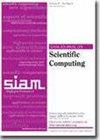A Bound-Preserving and Positivity-Preserving High-Order Arbitrary Lagrangian-Eulerian Discontinuous Galerkin Method for Compressible Multi-Medium Flows
IF 2.6
2区 数学
Q1 MATHEMATICS, APPLIED
引用次数: 0
Abstract
SIAM Journal on Scientific Computing, Volume 46, Issue 3, Page B254-B279, June 2024.Abstract. This work presents a novel bound-preserving and positivity-preserving direct arbitrary Lagrangian–Eulerian discontinuous Galerkin (ALE-DG) method for compressible multimedium flows by solving the five-equation transport model. The proposed method satisfies the discrete geometric conservation law (D-GCL) which indicates that uniform flow is precisely preserved during the simulation. More importantly, based on the D-GCL condition, we present a theoretical analysis on designing an efficient bound-preserving and positivity-preserving limiting strategy, which is able to maintain the boundedness of the volume fraction and the positivity of the partial density and internal energy, with the aim of avoiding the occurrence of inadmissible solutions and meanwhile improving the computational robustness. The accuracy and robustness of the proposed method are demonstrated by various one- and two-dimensional benchmark test cases. The numerical results verify the well capacity of the proposed high-order ALE-DG method for compressible multimedium flows with both the ideal and stiffened gas equation of state.
可压缩多介质流的保界和保正高阶任意拉格朗日-欧勒非连续伽勒金方法
SIAM 科学计算期刊》,第 46 卷第 3 期,第 B254-B279 页,2024 年 6 月。摘要本文通过求解五方程输运模型,针对可压缩多介质流提出了一种新颖的保界和保正的直接任意拉格朗日-欧勒非连续伽勒金(ALE-DG)方法。所提出的方法满足离散几何守恒定律(D-GCL),这表明在模拟过程中均匀流得到了精确的保留。更重要的是,基于 D-GCL 条件,我们从理论上分析了如何设计一种高效的保界和保正限制策略,该策略能够保持体积分数的有界性以及部分密度和内能的正性,从而避免出现不允许解,同时提高计算的鲁棒性。各种一维和二维基准测试案例证明了所提方法的准确性和鲁棒性。数值结果验证了所提出的高阶 ALE-DG 方法在理想气体和强化气体状态方程的可压缩多介质流动中的良好能力。
本文章由计算机程序翻译,如有差异,请以英文原文为准。
求助全文
约1分钟内获得全文
求助全文
来源期刊
CiteScore
5.50
自引率
3.20%
发文量
209
审稿时长
1 months
期刊介绍:
The purpose of SIAM Journal on Scientific Computing (SISC) is to advance computational methods for solving scientific and engineering problems.
SISC papers are classified into three categories:
1. Methods and Algorithms for Scientific Computing: Papers in this category may include theoretical analysis, provided that the relevance to applications in science and engineering is demonstrated. They should contain meaningful computational results and theoretical results or strong heuristics supporting the performance of new algorithms.
2. Computational Methods in Science and Engineering: Papers in this section will typically describe novel methodologies for solving a specific problem in computational science or engineering. They should contain enough information about the application to orient other computational scientists but should omit details of interest mainly to the applications specialist.
3. Software and High-Performance Computing: Papers in this category should concern the novel design and development of computational methods and high-quality software, parallel algorithms, high-performance computing issues, new architectures, data analysis, or visualization. The primary focus should be on computational methods that have potentially large impact for an important class of scientific or engineering problems.

 求助内容:
求助内容: 应助结果提醒方式:
应助结果提醒方式:


